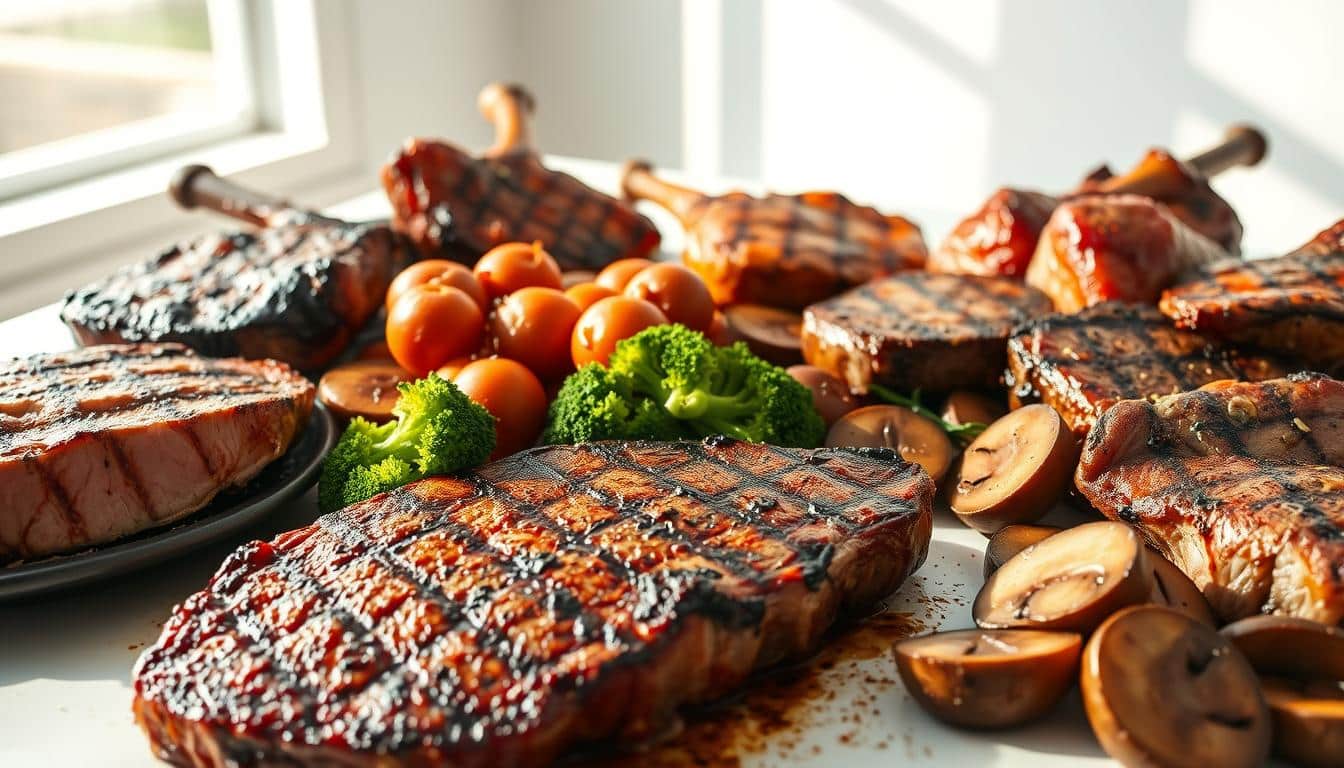Did you know that some athletes report improved recovery and mental clarity when following a meat-only eating plan? This approach, often called the carnivore diet, has gained attention for its potential to enhance performance and overall health. But is it the right choice for you?
In this article, we’ll explore the pros and cons of this eating style specifically for active individuals. From its high-protein focus to its potential impact on energy levels, we’ll break down what you need to know. Whether you’re a professional athlete or a weekend warrior, understanding how this diet affects your body is key.
We’ll also discuss practical tips and real-world examples to help you decide if this approach aligns with your training and health goals. Let’s dive in and uncover the truth about the carnivore diet for athletes!
Understanding the Carnivore Diet
Have you ever wondered what it’s like to fuel your body with only animal-based foods? This approach, often called the carnivore diet, focuses entirely on meat, eggs, and fish. It’s a simple yet strict way of eating that eliminates all plant-based options like fruits and grains.
What the Carnivore Diet Entails
The animal-based approach is straightforward. You eat foods that come from animals. This includes red meat, chicken, organ meats, and fish. Eggs are also a great option. The idea is to rely on protein and fats for energy, skipping carbs and sugars.
Foods like fruits, vegetables, and grains are off the table. This means no bread, pasta, or even salads. The focus is on simplicity and getting all your nutrients from animal sources.

Daily Meal Example on an Animal-Based Diet
Wondering what a day of eating looks like? Here’s an example:
- Breakfast: A juicy steak with a side of scrambled eggs.
- Lunch: Grilled chicken thighs with a small portion of white rice and cheese.
- Dinner: Pan-seared salmon or a beef liver dish.
- Snacks: Hard-boiled eggs or a handful of beef jerky.
This plan ensures you’re getting plenty of protein and fats to keep your energy levels steady throughout the day.
Carnivore Diet Benefits for Athletes
Active individuals often seek ways to optimize their nutrition for better performance. One approach gaining attention is the animal-based eating style, which focuses on high protein and fat intake. This method has shown potential in supporting muscle repair, reducing inflammation, and enhancing mental clarity.

Improved Muscle Repair and Growth
Protein is essential for repairing and building muscle, especially after intense workouts. The high-protein nature of this eating style ensures your body gets the nutrients it needs. Studies suggest that consuming 0.8 to 1 gram of protein per pound of body weight can significantly improve muscle recovery.
For example, a 200-pound athlete would aim for 160 to 200 grams of protein daily. This intake supports faster recovery and helps you stay strong and ready for your next training session.
Enhanced Recovery and Mental Clarity
Reducing inflammatory foods can lead to quicker recovery times. Many athletes report less joint pain and faster healing when following this approach. The absence of processed carbs also helps stabilize energy levels, preventing crashes during workouts.
Additionally, many active individuals experience improved mental clarity and focus. This can be a game-changer for those needing sharp cognitive performance during training or competitions.
| Benefit | How It Helps |
|---|---|
| Muscle Repair | High protein intake supports faster recovery and growth. |
| Reduced Inflammation | Eliminating inflammatory foods speeds up healing. |
| Mental Clarity | Stable energy levels improve focus and cognitive performance. |
Carnivore Diet Drawbacks for Athletes
While the carnivore diet has its perks, it’s not without challenges for active individuals. This eating style, focused solely on animal-based foods, can lead to nutrient gaps and energy issues. Let’s break down the key drawbacks you should consider.
Risk of Nutrient Deficiencies
One major concern is the lack of essential vitamins and minerals found in plant-based foods. For example, vitamin C and folate are scarce in meat, which can affect your overall health. Without these nutrients, your immune system and energy levels may suffer.
Additionally, low fiber intake can impact gut health. Fiber is crucial for digestion and long-term wellness. A lack of it might lead to discomfort or other digestive issues over time.
Possible Performance and Energy Challenges
Many athletes report feeling sluggish during the transition to this eating style. This is often called the “carnivore flu,” which includes fatigue and digestive discomfort. It can take weeks for your body to adapt fully.
Moreover, the absence of carbs might not sustain the high energy needs of intense workouts or games. Carbs are a quick energy source, and their restriction could affect your performance.
| Drawback | Impact |
|---|---|
| Nutrient Deficiencies | Lack of vitamins C and folate can weaken immunity. |
| Low Fiber Intake | May lead to digestive issues and discomfort. |
| Energy Challenges | Transition periods can cause fatigue and sluggishness. |
Optimizing Energy on an Animal-Based Diet
Fueling your body effectively is crucial for peak performance, especially when following an animal-based eating plan. While this approach focuses on protein and fats, adding carbs strategically can help sustain your energy levels during intense workouts. Let’s explore how to balance these elements for optimal results.
Incorporating Carbs Strategically
Carbs are a quick source of energy, and adding them around your training sessions can make a big difference. For example, a small portion of white rice before and after workouts can help fuel your muscles and aid recovery. Pairing it with protein-rich foods like chicken or eggs ensures you’re getting the best of both worlds.
Another great option is a mash of rice, meat, and cheese. This combination provides a mix of carbs, protein, and fats, keeping your energy steady throughout the day. Remember, the goal is to use carbs as a tool, not a staple, to support your performance.
Effective Meal Timing and Portion Control
Timing your meals can enhance nutrient absorption and energy levels. Eating a balanced meal 1-2 hours before training gives your body time to digest and convert food into fuel. Post-workout, aim to eat within 30 minutes to kickstart recovery.
Portion control is equally important. Overeating can lead to excess body fat, while undereating may leave you feeling sluggish. Focus on balanced meals that include protein, fats, and a small amount of carbs to meet your energy needs without overdoing it.
| Meal Timing | Benefit |
|---|---|
| Pre-Workout (1-2 hours) | Provides sustained energy for training. |
| Post-Workout (within 30 minutes) | Supports muscle recovery and replenishes energy stores. |
By planning your meals and timing them effectively, you can optimize your energy and performance on an animal-based eating plan. Small adjustments, like adding carbs strategically and controlling portions, can make a big difference in how you feel and perform.
Fueling Performance: The carnivore diet for athletes
Ever wondered how to maximize your energy and recovery with the right foods? For active individuals, the key lies in selecting high-quality protein sources and adding carbs strategically. This approach ensures you’re fueling your body for peak performance while supporting muscle growth and recovery.
Selecting High-Quality Protein Sources
Not all proteins are created equal. Opt for grass-fed red meats, free-range eggs, and wild-caught fish. These options are packed with essential nutrients and healthy fats that your body needs. For example, 80/20 ground beef is a great choice for meal prep, offering a balance of protein and fat.
Dairy products like cottage cheese or Greek yogurt can also be excellent post-workout snacks. They provide a quick protein boost while being easy to digest. Including a variety of protein sources ensures you’re getting all the amino acids your muscles need to recover and grow.
Adding Energy-Supporting Carbs When Needed
While the focus is on protein, adding small amounts of starchy carbs can help maintain energy levels during intense training. For instance, a handful of white rice or a baked sweet potato can provide the quick energy your body craves. Pair these carbs with a protein source like grilled chicken or salmon for a balanced meal.
Timing is key. Consuming carbs before and after workouts can fuel your muscles and aid recovery. This combination helps you stay energized and ready for your next session. Remember, the goal is to use carbs as a tool, not a staple, to support your performance.
By focusing on high-quality proteins and strategically adding carbs, you can fuel your body effectively. This approach not only boosts energy but also supports recovery and muscle growth, helping you perform at your best every day.
Nutritional Considerations for Training and Recovery
Staying hydrated and maintaining electrolyte balance is critical for peak performance. When following an animal-based eating plan, your body’s needs for fluids and minerals can shift. Proper hydration ensures your muscles function well and helps prevent cramps during intense workouts.
Managing Electrolytes and Hydration
Electrolytes like sodium, potassium, and magnesium are essential for muscle function and energy. When you’re active, you lose these minerals through sweat. Replenishing them is key to avoiding fatigue and maintaining strength.
Start by drinking plenty of water throughout the day. Add a pinch of salt to your meals to boost sodium levels. For potassium, include foods like eggs or small amounts of dairy. Magnesium can be found in bone broth, which also supports recovery.
Electrolyte drinks are another great option. Look for ones with no added sugars or artificial ingredients. These can be especially helpful during long training sessions or competitions.
Bone broth is a natural recovery aid. It’s rich in minerals and helps rehydrate your body after intense activity. Sipping it post-workout can speed up recovery and reduce muscle soreness.
To prevent cramps, monitor your fluid intake. Aim to drink water before, during, and after exercise. If you feel fatigued or notice muscle tightness, it might be a sign to adjust your electrolyte levels.
Tracking your hydration and performance can make a big difference. Keep a log of how much you drink and how you feel during training. Small adjustments in fluid and mineral intake can lead to significant improvements in energy and recovery.
Practical Tips for Adapting to the Carnivore Diet
Transitioning to a new way of eating can feel overwhelming, but with a few smart strategies, it doesn’t have to be. Whether you’re an active individual or just starting, these tips will help you adapt smoothly to an animal-based eating plan. Let’s break it down step by step.
Start with a Gradual Transition
Jumping straight into a meat-only eating style can shock your system. Instead, ease into it by slowly reducing your carb intake while increasing animal-based proteins. For example, replace one meal a day with a steak or eggs and gradually work your way up.
This approach helps your body adjust without feeling fatigued or overwhelmed. It also minimizes side effects like digestive discomfort, often called the “carnivore flu.” A smooth transition ensures you maintain energy levels for training and daily activities.
Plan Meals and Snacks Ahead of Time
Preparation is key to staying on track. Start by planning your meals and snacks for the week. Cook bulk portions of meat like chicken thighs or ground beef to save time during busy days. Portable options like beef jerky or hard-boiled eggs make great on-the-go snacks.
Having meals ready reduces the temptation to grab carb-heavy foods when you’re hungry. It also ensures you’re fueling your body with the right nutrients to support your training and recovery.
Here’s a simple meal prep idea:
- Breakfast: Scrambled eggs with bacon.
- Lunch: Grilled chicken thighs with a side of cheese.
- Dinner: Pan-seared salmon or a ribeye steak.
- Snacks: Beef jerky or boiled eggs.
By taking these steps, you’ll not only adapt more easily but also set yourself up for long-term success. A gradual transition and thoughtful planning can make all the difference in how you feel and perform.
Real-World Variations and Athlete Experiences
Many athletes have found unique ways to tailor their eating habits to match their training demands. From powerlifters to endurance runners, the carnivore diet has been adapted in various ways to suit individual needs. Let’s explore how real-world athletes have made this approach work for them.
Examples of Successful Diet Adaptations
Shawn Baker, a renowned advocate of the carnivore diet, focuses on high-protein meals like steak and eggs. He credits this approach for his improved strength and recovery. Similarly, Brock Lesnar, a former UFC champion, has incorporated animal-based foods into his routine to maintain peak performance.
Some athletes add small amounts of carbs, like white rice or honey, to fuel intense workouts. This hybrid approach, often called the “Performance Carnivore Diet,” combines the benefits of protein with the quick energy of carbs. For example, a triathlete might eat a mix of chicken and rice before a race to sustain energy levels.
Others include dairy products like cheese or yogurt for added variety and nutrients. These tweaks help athletes meet their nutritional needs while staying true to the core principles of the diet. Experimentation is key to finding what works best for each person.
| Adaptation | Benefit |
|---|---|
| Adding Carbs | Provides quick energy for intense training. |
| Including Dairy | Adds variety and essential nutrients. |
| High-Protein Focus | Supports muscle repair and growth. |
These real-world examples show that the carnivore diet isn’t one-size-fits-all. By making small adjustments, athletes can optimize their nutrition for better performance and overall health. The key is to listen to your body and experiment to find what works best for you.
Conclusion
Exploring an animal-based eating plan can offer both benefits and challenges for active individuals. On one hand, it supports muscle repair, reduces inflammation, and enhances mental clarity. On the other, it may lead to nutrient gaps and energy dips during the transition period.
Remember, individual needs vary. Experimentation is key to finding what works best for your body. Start with a gradual shift, plan your meals, and consider adding carbs strategically to fuel intense workouts. Listening to your body and making small adjustments can help you optimize performance and recovery.
Before making any changes, weigh the pros and cons carefully. Simple, step-by-step tweaks can make a big difference in reaching your goals. Stay curious, stay motivated, and find the balance that works for you.


